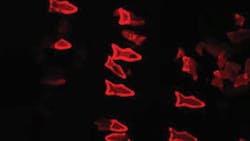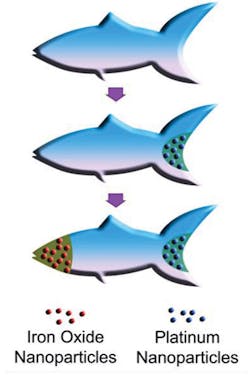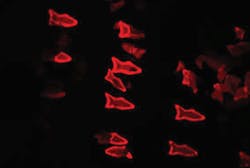This file type includes high-resolution graphics and schematics when applicable.
The science of boats is not new. Haul, sail, and motor design can be complex and tough to hone to specific applications, but the end goal is the same—to propel an object through water. However, new research may very well change the way we think of these aquatic-propelled vehicles.
On this front, Maurizio Porfiri, recipient of the 2015 C.D. Mote Jr. Early Career Award for his contributions in the field of vibration and acoustics, is working with polymers that efficiently transfer energy to propulsion, or allow forces from movement in liquids to generate energy. Porfiri used ionomers, a polymer group affected by electrical currents, to generate propulsion.
“Imagine a sponge that is able to contract and expand based on an electric charge rather than hydration,” says Porfiri. “There are no moving parts, which make this concept very quiet. Also, the process can be reversed. Using small currents and vortices, any motion in a liquid could potentially charge sensors or be used in piezoelectronics.”
This technology can allow for aquatic animals to be tagged with a sensor that has a sustainable power source, as long as the animal or water is moving. Not only could this revolutionize underwater electronics in general, but the Navy might be interested in the technology, too.
Porfiri says, “Imagine if a boat’s haul could flex. By tracking the pressures and energy in the water rather than on a rigid haul, we can determine what kind of energies could be generated by using this technology to transfer liquid movement to power the boat’s electronics. A flexible haul could also minimize the experienced drag, resulting in more efficient boat travel.”
On the other side of the US, professors at UC San Diego have developed a new advance swimming machine. By combining 3D-printing and micro-robotics technologies, a team lead by Shaochen Chen and Joseph Wang came up with complex geometries no wider than the width of a human hair (about 0.004 in.). Chen is able to print hundreds of these micro-robots in seconds. Each fish-shaped swimming machine, which measures 120 microns long and 30 microns thick, is 3D printed on a process developed in Chen’s lab called microscale continuous optical printing. A digital micro-mirror device chip contains approximately two million micro-mirrors. A desired geometry is selected, like a fish, and the mirrors project the image into a photosensitive material, one cross-section at a time, until the shape is completed.
For this case, a fish shape was created. Platinum added into the tail propels the fish as it reacts with hydrogen peroxide. With this technique it was possible to add iron oxide to the head of the fish, which allows for control via magnets.
These swimming machines could be used to clean toxins from liquids. In an experiment, the fish bonded with the toxins, and fluoresced in a red glow. Co-author Jinxing Li said, “Another exciting possibility we could explore is to encapsulate medicines inside the microfish and use them for directed drug delivery.”



